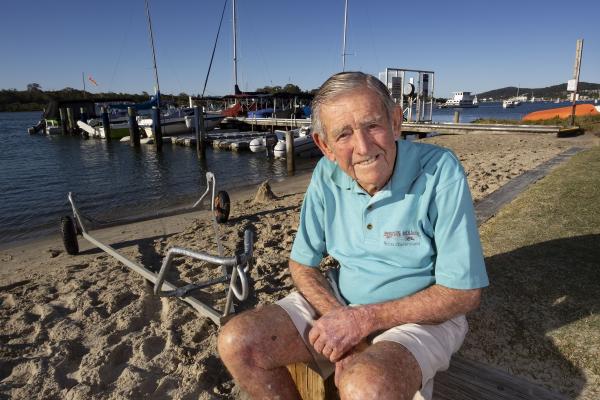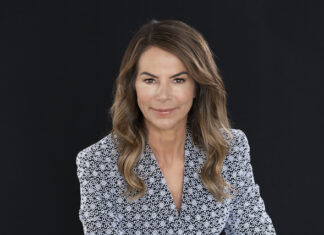Maybe it was the Sunday trips to the beach as a boy or the gun-toting lifesavers that led to a career around water for 89-year-old Lloyd Cairns whose connection with the region tells much about the changing face of Noosa. He spoke to Noosa Today about those heady days.
Born in Eumundi hospital, attended by Dr Henderson and Nurse Luke, in 1931 Lloyd spent his early years in the centre of the village. His father was the local mechanic and the family lived next-door to Adam’s garage at the boarding house owned by his grandmother, who was also the station mistress.
“We used to go over the road to meet the trains,“ he said.
A trip to Noosa was a weekly event when Lloyd was a boy when the cream carrier would pick up locals on a Sunday to go to the beach.
It was a place Lloyd remembers being full of shells particularly after rough weather. “Kids would have competitions making shell gardens,“ he said.
“Opposite the surf club George Hay lived in a house that always had a boat being built in the backyard – about 25 ft. There was a mango tree between, now it’s Betty’s Burgers“.
There was no rock wall and the surf club, of which Lloyd later became an associate member, was a shed on the beach with a 25 foot tower and no such thing as shark nets.
“The lifesaver would be armed with a .303 to chase the sharks,“ he said. “They’d ring a bell, everyone would run out, and they’d shoot at the sharks.“
Lloyd remembers the river and beach area as being “very ordinary” at the time and covered in “saltwater grass” but it didn’t deter the visitors to Munna Point which “was very popular”.
“People would go fishing and camping. It was pretty rough. No electricity. They had a shed on the grounds with a tank – that was all the water you got. Sometimes you had to wait for council to fill it up.
“When they put in a block of toilets – that was the first building with electricity.
“They had electricity at the end of the war – one at the tennis court, one at Maisies.”
When Lloyd’s mother was a girl she used to ride her horse to Tewantin to attend the dances at a hall across from the Royal Mail where they were permitted to sleep for the night on the verandah. In Lloyd’s day Lionel Donovan ran the bus run.
“He’d pick up visitors from the train at Cooroy and bring them to Noosa. He’s stop at the Royal Mail, which he owned, for lunch – it served good food. If people wanted to go and hire one of the motor boats they’d pack them up with a picnic lunch.”
Tewantin was a popular holiday spot, especially with people arriving from the Ipswich coal mines, he said.
Fires were also a frequent visitor to Tewantin. Lloyd remembers two pubs, the picture theatre and guest house going up in smoke. “Martin’s Hotel was the first one to burn down,“ he said.
“When the Royal Mail burnt down they built a tin shed and kept serving.
Donovan’s picture theatre located across the road went up in flames. It wasn’t replaced and neither was the San Ilandra guest house that was located on the site of Noosa Council Chambers before it went up in a big blaze, he said.
When money got a bit tight at home Lloyd’s family moved to Brisbane where his father worked again as a mechanic, but when war broke out he returned to live at his grandparents dairy at Beddington.
When he was old enough Lloyd returned to Brisbane where through a friend’s father he gained a job servicing lighthouses along the east coast of Queensland to PNG. He remained working in the job and enjoying fishing on the reef in his off-time for eight years until he married his wife Kathy Kuhn and decided he needed to spend more time at home.
The couple moved into a flat at Kelvin Grove while Lloyd worked with his father. But the draw of the sea took hold again and in 1958 he was on a prawn trawler in Moreton Bay before taking on the role of seaman with the hydrological survey department of Harbours and Marine as they surveyed the coast from Brisbane to Kurumba.
In 1970 Lloyd and Kathy bought a high set house in Tewantin, which remains his home, for $6500 – “quite a bit at that time“.
“The real estate told me you won’t make anything out of this for a few years,“ he laughed.
“It was pretty quiet. There was no house below me, nothing on the east side. It was all open and full of kangaroos. In winter they’d come and lay in the yard. We had a big billy goat. He’d team up with them.“
Lloyd began work issuing speedboat licenses for recreational boaties, a job he held for 27 years.
Ahead of his time he worked from a home office, and operated from the Noosaville boat ramp. When he started a license was $5, then it went up to $15 and when he finished it was $30. Today it’s about $100 more.
“I knew a lot of them on the boats,“ he said. “90 per cent of them were good to deal with.“
Fishing was the major attraction for speedboats and fish were plentiful. Seeing mullet jumping in the river was commonplace, there were flathead around the new moon and plenty of lovely whiting, Lloyd said. It was a fishing friend, Bruce McConnell, who introduced him to the Tewantin-Noosa bowls club one day. “We left the Royal Mail and walked to the bowls club. They had food on the bar. We were eating sea scollops,“ he said. “What did you come for – a feed?“ he was asked so he decided to join the club and remained a member for 46 years. “It only opened up Friday, Saturday and Sunday. My parents lived on the esplanade. It was nice and handy.“
New developments and an influx of residents from Victoria, regarded as “the white shoe brigade“ signalled a change from the layback lifestyle Lloyd enjoyed.
“The destruction of Hay Island made a big difference to the roe habitat. It was during the Bjelke Petersen era. They bulldozed it out. Now it’s Noosa Sound.“
The river he now considers “too busy, too many speedboat,“ and gone are the people who lived in sheds or “gunyahs“, as they were known, among the mangroves along the river. One memorable character, Fred Gordon with his blue cattle dog, used to catch fish he’d push around in a wheelbarrow to sell. “He got a few bucks and built a boat on the edge – 30 ft high – The Oliver Twist,“ he said.
When people saw it they’d say “here comes one helluva twist,“ Lloyd said. Noosa was a place of dreams where anything goes and everything was possible.







